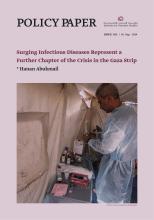Heather Stobaugh of Action Against Hunger said that the greatest threat in Gaza is severe acute malnutrition, which occurs when people do not get the vitamins, minerals, and proteins that enable the body to perform its functions.
Heather Stobaugh of Action Against Hunger said that the greatest threat in Gaza is severe acute malnutrition, which occurs when people do not get the vitamins, minerals, and proteins that enable the body to perform its functions.
Heather Stobaugh of Action Against Hunger, says children are at highest risk of dying. "So the severe acute malnutrition that you’ve mentioned before is the deadliest form of hunger and it’s the biggest threat right now in Gaza."
UK charities have urged British Prime Minister Rishi Sunak to put substance to his claim of combating world hunger by calling for a ceasefire and an end to the siege in Gaza.
Farms and farmers in southern Gaza have also been affected. Action Against Hunger found that of the 113 farmers in southern Gaza surveyed between 19 and 31 October, 60 per cent reported that their property and/or crops had been damaged, 42 per cent said they did not have access to water to irrigate their farms, and 43 per cent said they were unable to harvest their crops.
The people of Gaza could be facing an even worsening crisis – on top of Israel’s assault, which has killed over 13,000 people – due to worsening weather conditions and winter setting in. That’s the assessment of Action Against Hunger.
Two million civilians in Gaza are suffering hunger, displacement, and risk of death on an unprecedented scale. Their appalling situation is the responsibility of all parties to the conflict. As humanitarian organizations working in Gaza, Doctors Without Borders/Médecins Sans Frontières (MSF), International Rescue Committee, and other nongovernmental organizations (NGOs) have repeatedly urged the use of all means available to relieve the suffering, in accord with the humanitarian principles of humanity, impartiality, neutrality, and independence.
Lack of access to water is one of the biggest challenges in Gaza, according to the international charity Action Against Hunger, which is warning of “a health crisis on the brink of explosion”. Staff at the charity say overcrowded displacement shelters are close to breaking point. They add that one shelter in Gaza is currently supporting more than 24,000 people and that 60% of the children there are affected by diarrhea. Some people are also resorting to open defecation.
Farms and farmers in southern Gaza have also been affected. Action Against Hunger found that of 113 farmers from southern Gaza surveyed between October 19 and 31, 60 percent reported that their assets and/or crops have been damaged, 42 percent reported that they had no access to water to irrigate their farms, and 43 percent reported that they were unable to harvest their crops.
Gaza famine warnings and starvation deaths in Ethiopia’s Tigray have put extreme hunger in the spotlight. But where are the worst hunger crises around the globe, and are those affected getting the help they desperately need? A report released on 16 January helps unpack this, while flagging that only 35% of the funding needs for crisis levels of hunger were met last year. Action Against Hunger analyzed the needs of 17 countries whose hunger burden was at crisis level or worse in 2022 and for whom funding data for 2023 was available (Gaza was not included).
"This tragic incident of a young girl dying from hunger is a stark reminder of the severity of the crisis in Gaza, with hunger at catastrophic levels and children being particularly vulnerable to starvation," Jean-Michel Grand, Executive Director of Action Against Hunger UK told Middle East Eye.
Israel launched a new assault against the Palestinian people in the Gaza Strip which began officially on October 7, 2023. In this assault, Israel's occupation army, with full political coverage, targeted all infrastructure installations in Gaza, especially the health sector which was singled out in a systematic and unprecedented manner, indicating the existence of a preconceived Israeli plan to destroy the heath infrastructure in the northern part of the Strip to make it unlivable and to drive its population southwards (the plan had originally envisaged their expulsion to Egypt but when this fell through it was decided to drive that population to central and southern Gaza). This deliberate and systematic targeting campaign vented itself in the indiscriminate bombing of urban quarters and high-rise residential towers in order to butcher the largest number of civilians and to systematically destroy all health facilities, with a view to forcing the population to head southwards where health facilities and medical emergency services had already far exceeded their absorption capacities. Read more
المصادر:
المصادر:
المصادر:
المصادر:
